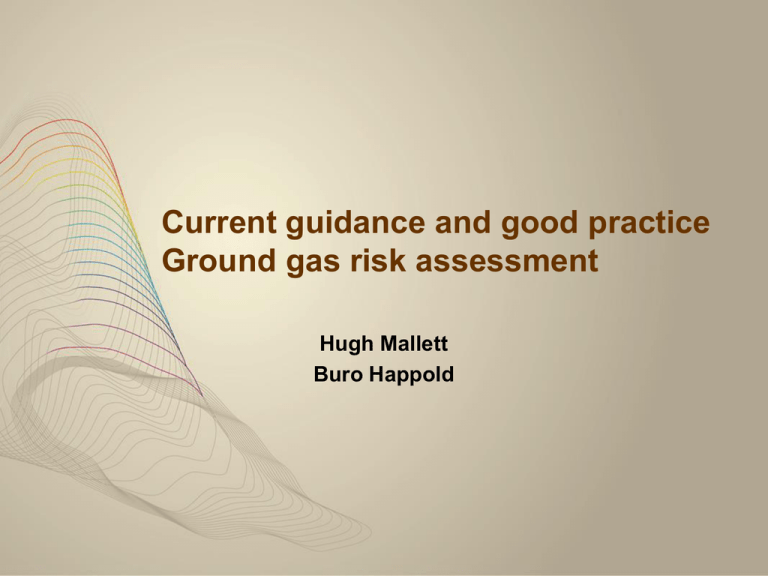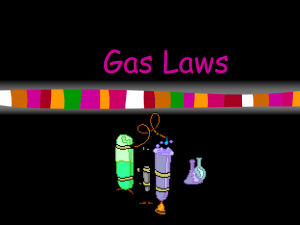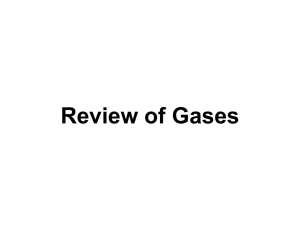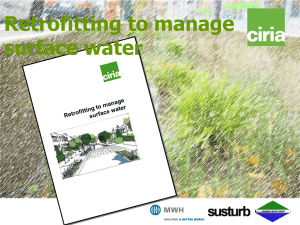Ground gases – Guidance & good practice
advertisement

Current guidance and good practice Ground gas risk assessment Hugh Mallett Buro Happold Ground gases – Guidance & good practice Contents 1. Guiding principles 2. Investigation & monitoring 3. Data, risk assessment tools & remedial strategy 4. Case study 5. Conclusions Ground gases – Guidance & good practice Guiding Principles “It’s the economy, stupid” Ground gases – Guidance & good practice Guiding Principles “It’s the Conceptual Site Model, stupid” Ground gases – Guidance & good practice Figure 1. Guiding Principles The Process of Managing Risks Related to Hazardous Ground Gases Site Characterisation Assessment of Risk Define the context & set the objectives Determination / Validation of Remediation Identify remedial objectives to mitigate unacceptable risks Review data Carry out Phase One Desk Study Identify feasible remedial options Is data reliable? (e.g. appropriate response zones, variable/ unrepresentative groundwater levels) Develop initial conceptual site model & undertake preliminary risk assessment Phased assessment process No Undertake additional intrusive investigations Yes No Has development of model included site specific factors that may influence gas/vapour regime Has monitoring been carried out under varying conditions likely to influence the gas vapour regime? No Undertake additional intrusive investigations and/ or monitoring & sampling Yes Accords with CLR 11. Set out in C665 Yes Yes Yes Detailed evaluation of remedial options Source(s) of gas(es)/ vapour(s) identified? No Develop a remedial strategy Yes Yes No Design, implementation & verification of remedial measures No Extent of source(s) established? Yes Are there potential unacceptable risks ? Refine conceptual site model No Stage 1: Site characterisation No No Results sufficiently consistent/ reliable? Have these factors identified the potential presence of gas/vapour? No Illustrates principal stages of assessing risks presented by LFG Has sufficient data been obtained to allow the selection/ design of appropriate remedial solutions? Consider odour & toxicity and incorporate into risk assessment as appropriate Yes Review/ amend remedial strategy Is post installation/ construction monitoring required? Yes Identify further actions to clarify potential unacceptable risks Undertake appropriate risk assessment modelling. Define gas regime Undertake post installation/ construction monitoring Establish objectives of any further investigations Stage 2: Assessment of risk Green No Stage 3: Determination/ validation of remediation Amber Red Is the monitoring data acceptable? Carry out further investigation [desk based/intrusive/ Monitoring] Does risk assessment demonstrate corrective action required? Yes Completion/Validation Report Yes NO FURTHER ACTION REQUIRED NO FURTHER ACTION REQUIRED NO FURTHER ACTION REQUIRED No Ground gases – Guidance & good practice Guiding Principles Published Guidance The age of enlightenment ? CIRIA 149. DETR [PIT] BRE 414 CIRIA 149 NHBC. BS8485 Ground Gas Handbook Good practice in ground gas risk assessment 2. Guidance - Investigation & monitoring Ground gases – Guidance & good practice Phase 1 - Desk Study Objectives Information sources Initial conceptual site model Preliminary risk assessment Ground gases – Guidance & good practice Phase 2 - Intrusive investigation Objectives Exploration techniques [intrusive & non intrusive] Spacing Design of response zone Phasing Ground gases – Guidance & good practice Phase 2 - Monitoring Monitoring: frequency/ period Well defined protocol Correct kit Falling / low pressure Comprehensive data Monitoring pro forma Intelligent recording Ground gases – Guidance & good practice Phase 2 - Sampling Sample & analysis Lab data confirms field results type source Sampling protocol) Lab techniques (GC, ICAMS, carbon dating etc.) Good practice in ground gas risk assessment 3. Data, risk assessment tools & remedial design Ground gases – Guidance & good practice Data assessment Reliability Temporal variability Consistency Source identified Source extent defined Ground gases – Guidance & good practice Data assessment Defined thresholds 60 50 Gas Screening Values [GSVs] Celsius CH4 30 CO2 Temp / Qualifying Criteria 40 O2 % 20 Flow rate measurement Temp 10 0 Temporal resolution of discrete 28 30 32 34 -10 Day measurements Uncertainty 36 38 40 Ground gases – Guidance & good practice Risk assessment tools Guidance GQRA [CIRIA 552] Modified Wilson & Card [CIRIA C665] NHBC BS8485 Inconsistency & confusion? Ground gases – Guidance & good practice Risk assessment tools Guidance Guidance: “Advice / information aimed at resolving a problem, difficulty” Commandment: “Divine formal order or instruction to obey” Sensible application of guidance by experienced professionals Challenge the data to make informed judgement Ground gases – Guidance & good practice Risk assessment tools CIRIA C665 & NHBC Calculate GSVs Determine Characteristic Situation Limiting values Consider modifying factors Robustness of data Source characterisation Flow rates Development type Generic scope protection measures Ground gases – Guidance & good practice Risk assessment tools BS8485. CS Private housing Public buildings Commercial Industrial 1 0 0 0 0 Development Sensitivity 2 3 3 2 1 Determine remedial 3 4 3 2 2 measures scores 4 6 5 4 3 6 5 4 7 6 GSV and CS 5 6 Ground gases – Guidance & good practice Risk assessment tools BS8485. Achieve score by Combination of; 1. Venting/ dilution 2. Barriers 3. Membranes 4. Monitoring & detection 5. Pathway intervention Ground gases – Guidance & good practice Risk assessment tools BS8485. Tables 2 & 3 - arbitrary Consider moderating factors (Annex B) • Location of source • Consistency of source • Risk rating of gas regime • Pathway permeability • Foundation conditions • Complexity of substructure • Validation of installed measures • Maintenance requirements • End use sensitivity Use BS scores sensibly What else can we do? Ground gases – Guidance & good practice Risk assessment tools Site specific modification Void space Development type Footprint Vulnerable space Maximum concentrations Foundation solution etc Ground gases – Guidance & good practice Risk assessment tools Mathematical models - Source 1. EA Gas Generation [Q=10MT/8760 m3/hr] 2. Surface emission (Peckson) [Borehole emission rate l/hr/10=surface emission rate l/m2/hr] 3. Atmospheric pressure drop P1.V1=P2.V2 [Boyle’s Law] 4. Gas Sim Source term; emission; migration; exposure Ref CIRIA C655 Appendix 5 Ground gases – Guidance & good practice Risk assessment tools Mathematical models - ventilation Ventilation capacity of void space BS5925:1991 Building Regulations Ventilation capacity of void former Ventilation capacity of active system Darcy’s Law Ground Gas Handbook Good practice in ground gas risk assessment 3. Case study Ground gases – Guidance & good practice Site in East London • 7m Made Ground • 13 standpipes • Majority 2 readings • Elevated gas 50% occasions • CH4 7%; CO2 12%; Flow 1l/hr • GSV 0.05 – CS1 Ground gases – Guidance & good practice But • Very limited data set • 50% readings > limiting criteria • Gas more elevated in east ? • Thickness/ nature of MG • Sensitivity of development Determine Design classification as CS2 (west zone) and CS3 to east Ground gases – Guidance & good practice Gas Protection measures 1.CIRIA – Slab, membrane +venting 2.BS 8485. Score 3.5 against target 2. 3.Check ventilation a) Required flow 60m3/hr [Darcy – Equil Conc <1%] b) Req’d ventilation area 5+70mm2/m [B Regs 1500mm2/m] Min spacing of vents = 45m Risk “dead spots” Design spacing 25m c) Flow thro void former 30x > req’d flow. 4. Peer review 5. Scrutiny by LPA expert Ground gases – Guidance & good practice Series of Electricity Sub Stations 1.GSV 2.2 (methane) - CS2/3 2.Standard GRP enclosure 3.Massive concrete slab (part) 4.Service entries in side wall 5.Ventilation for cooling 6.Spark suppression 7.GSV & emission rate 8.>>Building Regs ventilation rate 9.Time to reach 5% CH4 in still conditions 10.Ventilation requirement vs ventilation achieved by standard construction No specific additional gas protection Approved by LPA expert Ground gases – Guidance & good practice After all of this investigation, data collection and complex risk assessment … Do not forget the importance of verification Ground gases – Guidance & good practice Verification The QA / inspection process Contractor employed specialist supplier and installer Check sheet system Prior to concrete pour Each section Inspected & Signed off by: Installer Buro Happold Main Contractor Check Sheets and photographic record – Appendix in verification report Ground gases – Guidance & good practice Concluding comments 1. Understanding CSM is critical 2. Reliable data – key component 3. Generic models – site specific modification 4. Combine systems to achieve BS “score” 5. Math tools – aid understanding/ increase confidence. A tool to help you make the decision. 6. Site verification 7. Application requires thought [“The strength of the Guidance is that it still relies upon judgement”] Ground gases – Guidance & good practice References 1. CIRIA 149. 1995. Protecting development from methane 2. DETR [PIT] 1997. Passive venting of soil gases beneath buildings 3. BRE 414. 2001. Protective measures for housing on gas contaminated land 4. CIRIA C665. 2007. Assessing risks posed by hazardous ground gases to buildings 5. NHBC. 2007. Guidance on evaluation of development proposals in sites where methane and carbon dioxide are present 6. BS8485. 2007. Code of practice for the characterisation and remediation from ground gas in affected developments 7. Wilson Card & Haines. 2008. The Ground Gas Handbook








